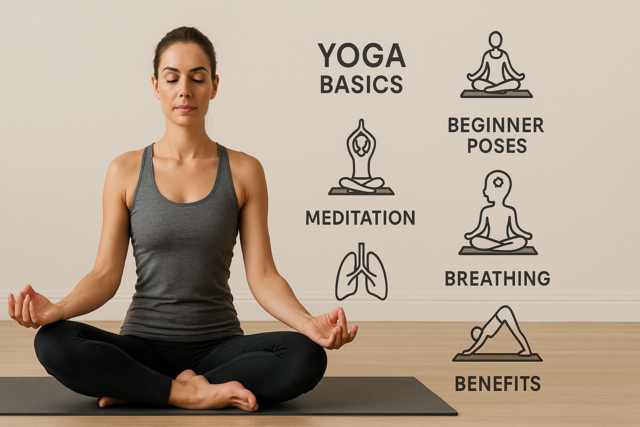My goal is to encourage you to incorporate healthy nutrition and exercise habits so that you can be healthy. You probably already know some healthy habits regarding nutrition and exercise. Maybe you need a little boost to have a healthier lifestyle, or perhaps nutrition habits are new to you. In this article, we will discuss what your nutrition and health goals are, so your goals will be clear to you.
We will cover the basics of nutrition � the food groups, vitamins, and minerals, incorporating exercise in your routine, and other healthy habits. We also will cover other interesting topics that you may find useful for improving your health, such as maintaining a healthy weight, reducing stress, increasing your energy, and preventing some health problems.
Healthy lifestyle habits, such as nutrition and exercise, are very important. They affect your overall health, energy, and everything you do. I want to help you gather the skills you need to succeed at your nutrition goals.
We've all heard the saying, "An apple a day, keeps the doctor away." This is so true. We're in control of our health and how healthy we are. True, part of our health is handed to us through genetics. However, it's really amazing what a huge influence we have on our health through our daily habits.
Many of us have heard of the USDA Food Pyramid. The original USDA Food Pyramid was created in 1992 and used until 2005, when the USDA created a new food pyramid. There might be some confusion, since some of us are used to the original food pyramid.
The original USDA Food Pyramid started at the bottom layer with 6-11 servings of bread, cereal, rice, and pasta. The next level was divided between the vegetable group (3-5 servings), and the fruit group (2-4 servings). The next higher level contained the dairy group -- milk, yogurt, and cheese -- (2-3 servings), and the protein group -- meat, poultry, fish, dry beans, eggs, and nuts -- (2-3 servings). Finally the very top level was occupied by fats, oils, and sweets, which were to be consumed sparingly. In the original food pyramid, we were supposed to eat more foods from the bottom of the pyramid, and less from the top.
Fortunately, the USDA has created a new food pyramid, because the original version contained some flaws. It indicated that:
- All fats are bad. Actually, some fats are good for you, while some fats can lead to clogged arteries, strokes, heart disease, and other problems. The old food pyramid didn't make this distinction.
- All carbohydrates are good. Some carbohydrates are healthier than others. If you eat the wrong kinds of carbohydrates, you could end up with problems, such as weight gain and heart disease.
- All protein is the same. Not all protein is the same. Red meat, chicken, fish, eggs, beans, and nuts are all excellent sources of protein. But what comes with the protein package? Red meat is not as a healthy choice as fish, since red meat comes with saturated fat and cholesterol.
In 2005, the USDA created a new food pyramid. They turned the pyramid over so that all the food group bands run vertically from the top to the bottom. Each food group band is a different width, depending on how much we need from each food group.
Here is a key to each food group band:
- Orange is for grains.
- Green is for vegetables.
- Red is for fruits.
- Yellow is for oils.
- Blue is for dairy.
- Purple is for protein.
3. Other Food Pyramids
4. MyPlate
In 2011, the government relegated the well-known food pyramid to the sands of history, unveiling a new, simpler image of a plate divided into basic food groups. After devoting decades to designing a pyramid, then honing and refining that design, the nation's nutrition experts have settled on what they believe is the perfect geometry to represent what we should eat -- a plate. The new design, called MyPlate, was conceived as a crucial part of a national campaign against obesity, designed to remind consumers about the basics of a healthful diet.
The plate is split into four sections, for fruit, vegetables, grains and protein. A smaller circle sits beside it for dairy products. "MyPlate" promotes fruits and vegetables, which cover half the circle. Grains occupy an additional quarter, as do proteins, such as meat, fish, and poultry. A glass of milk rests to the side. Desserts have been banished to the desert. The Plate has the potential to be really helpful because it allows people to quickly and visually rate their plate and try to get it to look like the icon without measuring or counting.
Experts still believe a plate would be a good choice. Nutrition experts are glad to see both versions of the pyramid go. They say they're complicated, and sometimes give the wrong ideas about certain foods. They also hope that in addition to being simpler, the new symbol will place a greater emphasis on the need for physical activity. The symbol also should be small, representing the need for smaller portion sizes. Portion size, even of healthy foods, plays a major role in controlling weight and reducing the risk of a number of chronic diseases. Experts also hope the new symbol and its messages about proper nutrition don't ignore the need for exercise.
When all is said and done, the new design incorporates seven key dietary messages:
- Enjoy your food, but eat less
- Avoid oversized portions
- Make half your plate fruits and vegetables
- Drink water instead of sugary drinks
- Make at least half your grains whole grains
- Switch to fat-free or low-fat (1 percent) milk
- Compare sodium in foods like soup, bread, and frozen meals - and choose the foods with lower numbers.
Goal Setting and Nutrition
In order to improve your nutrition and health, I want you to create some clear nutrition goals. I will discuss some steps to make some achievable goals, and then you will have the chance to write goals that are meaningful for you. When your goals are achievable and clear, you will be able to make some important changes for your health. Don't worry about creating goals that are perfect. As long as the goals are meaningful to you, that's the main thing.
Creating S.M.A.R.T. Goals
SMART is an acronym for specific, measurable, attainable, relevant, and time-based.
1. Specific � Goals that are specific are more likely to be accomplished. They are easier to accomplish, too. To create a specific goal, have the six "W" questions in mind:
- Who? Who is involved?
- What? What do I want to achieve? What change do I want?
- Where? Where will I carry out this goal?
- When? When will I do this goal?
- Which? What are the requirements and constraints of this goal?
- Why? What will I gain from doing this goal? What are the benefits?
An example of a general goal would be, "Be fit." A more specific goal would be, "I will work out three days a week." It's important to create goals that are positive, too. For instance, "Not be fat" is not as a fun goal as, "Look healthy."
2. Measurable � Goals that are measurable have some criteria that you can measure to see if you are attaining your goal. For example, if you want to lose 10 pounds by a certain date, that is very measurable.
3. Attainable � Goals need to be attainable. An attainable goal is one that might have some challenge, but you know you can reach it. If you have a big goal, one way to make the goal more manageable is to break the goal into smaller steps. For instance, if you need to lose a lot of weight, you might start with losing five pounds this month. Losing five pounds is a smaller, easier goal to achieve. It's also more fun to reach your big goal, if you accomplish smaller goals along the way.
4. Relevant � Make a goal relevant and have meaning for you. Pick a goal that will give you happiness, or that you will benefit from. Maybe you would feel great if you were back to your thinner self. Or perhaps you'd feel like a million bucks if you gained weight. You know what's right for you. Goals are a lot more fun and motivating when they are relevant.
Making changes in our health and nutrition that are relevant is especially important. For example, whole wheat products are said to be very healthy; however I get an allergic reaction to whole wheat products. My brother says he is allergic to certain vegetables. (I wish I was allergic to vegetables!) So if I discuss how healthy fish is, but you know it's not right for you, that's definitely okay.
5. Time-based � Set a goal that has an end date. Let's say you want to lose 10 pounds. Set a date for that goal. Even if you really lose eight pounds by that date, at least you have a date to strive for. If you are working on your goal, that's what counts.
Now you create goals (or a main goal) that will help you create some positive changes for your health. Once you are clear what your goals are, you can be motivated to apply your goals to your life. Start a journal in a notebook or your computer, and write down your specific goals. Writing your goals makes them more real. Also, since your goals are related to nutrition, and perhaps fitness, discuss your goals with your doctor to confirm that they are right for you.
Exercise #1:
Write some health-related goals that go by the SMART criteria. Write a main goal or some smaller goals that will influence your nutrition habits and health in positive ways. Write them in your notebook or in your computer so you can refer to them when you want to. Maybe you want to eat more nutritious food, lose weight, or have more energy.






























